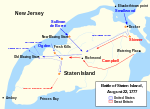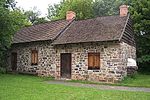LaTourette House
Federal architecture in New York (state)Houses completed in 1836Houses on the National Register of Historic Places in Staten IslandNew York City Registered Historic Place stubsStaten Island building and structure stubs ... and 3 more
Staten Island geography stubsUse American English from June 2022Use mdy dates from June 2022

LaTourette House is a historic home located at New Springville, Staten Island, New York. It was built in 1836 in a late Federal / early Greek Revival style. It is a large, sturdy gable roofed brick farmhouse with stone trim. In 1928 the house and 500 acres were purchased by New York City for a golf course and the house was converted to a clubhouse. The large, white "L" shaped wood porch and one story extension were added in 1936 as part of a Work Projects Administration restoration project.It was added to the National Register of Historic Places in 1982.
Excerpt from the Wikipedia article LaTourette House (License: CC BY-SA 3.0, Authors, Images).LaTourette House
Richmond Hill Road, New York Staten Island
Geographical coordinates (GPS) Address Phone number Website Nearby Places Show on map
Geographical coordinates (GPS)
| Latitude | Longitude |
|---|---|
| N 40.576111111111 ° | E -74.147222222222 ° |
Address
La Tourette Golf Course
Richmond Hill Road 1001
10306 New York, Staten Island
New York, United States
Open on Google Maps









